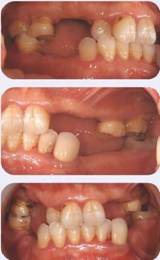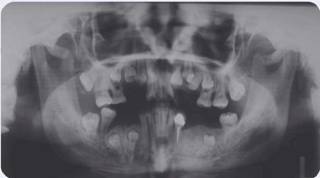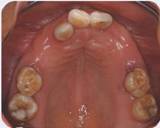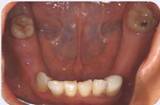
Management of cleidocranial dysplasia II— treatment of an adult patient
CASE STORY
A 49-year-old female patient presents with a chief complaint of “I want to be able to smile without feeling self-conscious.” The patient is diagnosed with cleidocranial dysplasia (CCD). Her dental treatment has typically involved extraction of mobile or carious teeth and replacement of missing teeth with removable prostheses. See Case 36 for presentation of this patient’s son.
Figures 1, 2, and 3: Right, left, and maximum intercuspation.

Figure 4: Panoramic radiograph.

Figure 5: Maxillary occlusal view.

Figure 6: Mandibular occlusal view.

LEARNING GOALS AND OBJECTIVES
- To recognize signs of cleidocranial dysplasia (CCD)
- To discuss treatment approaches for an adult patient with CCD
- To understand the advantages and disadvantages of various treatment options
- To manage CCD dental treatment with a multidisciplinary approach
Medical History
- Cleidocranial dysplasia
Dental History
- Extraction of mobile or nonrestorable teeth
- Endodontic therapy of mandibular left canine
- Removable partial dentures
- Full coverage metal-ceramic restorations
Medications and Allergies
- Birth control pills
- No known drug allergies
Review of Systems
- Vital signs:
- Blood pressure: 122/80
- Heart rate: 72 beats/minute
- Respiration rate: 16 breaths/minute
Soft Tissue Examination Findings
- No significant findings
Charting
(See Fig. 7.)
Significant Clinical Findings/Problem List
- Partial edentulism
- Reverse articulation—left posterior
- Reverse articulation—anterior, involving maxillary right lateral incisor (7)
- Periodontal disease, including but not limited to furcation involvement of maxillary primary left and right second molars (A and J)
- Class II mobility of mandibular right first molar (30)
- Periapical pathology and pain of mandibular left canine (22)
Diagnosis
- Cleidocranial dysplasia
- Partial edentulism
- Periradicular periodontitis
- Anterior and posterior cross articulation
- Localized severe periodontal disease
Clinical Decision-Making Determining Factors
- Cleidocranial dysplasia (cleido refers to the collar bone, cranial refers to the head, and dysplasia refers to abnormal forming) is an autosomal dominant condition that is often genetically inherited. The patient presented in this case story did not inherit the condition from either parent. It is reported that of all cleidocranial dysplasia cases, the majority are genetically inherited, but up to one-third can be spontaneous genetic mutations. This patient has also passed CCD on to her son (see Case 36). It is transmitted as an/>
Stay updated, free dental videos. Join our Telegram channel

VIDEdental - Online dental courses


